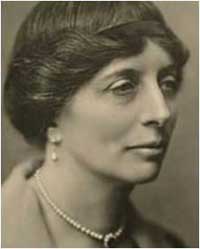Katherine Ramsay, Duchess of Atholl 1874-1960
 To some Katherine is a contradiction. It may seem odd that the first Woman to be elected an MP was a Conservative and an anti-suffragist to boot!
To some Katherine is a contradiction. It may seem odd that the first Woman to be elected an MP was a Conservative and an anti-suffragist to boot!
As a member of the aristocracy, Katherine regarded it her duty and her right to do some form of public service. Her views nowadays would be regarded as elitist and snobbish but were nothing out of the ordinary then.
Her childhood was not happy. She was recalled home in the middle of her music studies to be married to the Marquis of Tullibardine. She followed him in his military adventures and was awarded the Dame of British Empire for her services to the war effort in 1918. Katherine was unable to have children, which caused her pain, not least because the primary role of an aristocratic wife is to provide an heir.
She was her husband’s helpmate in the 1906 election (where he lost) and in the 1910 in which he won a seat for the Conservatives, going out canvassing and speaking in numerous public meetings on his behalf. They both opposed all suffrage organisations, constitutional or militant. Their views earned them the contempt of Lady Frances Balfour especially His attempt to link the rise in venereal disease with female suffrage.
Katherine only saw better off women, those with time on their hands as suitable for enfranchisement. She herself was on 25 different committees by 1920. She expected others to show a similar level of commitment thereby displaying her complete ignorance of the work that other women had to do to look after their families. Her opposition to franchise reform rested on the 'defence of the realm' argument. Once women over 30 got the vote in 1918 Katherine did her best to prevent parity at 21.
Katherine sought to improve the social position of women but she certainly did not seek to empower them. She was in favour of child labour – nimble fingers argument as well as the ‘economy will collapse’ one. She was not in favour of women’s subordination to men – she realised that enfranchisement had changed that.
In 1912 she was invited onto the Scottish committee investigating the medical and nursing services in crofting areas. She was appalled at the conditions that the crofters lived under but although the medical services were improved, nothing was done to alter the ownership of land that was the root cause of the ill health – after all the Atholl’s were among the largest landowners…
She, and others, recommended giving travelling people housing in areas of employment only if they agreed to give up alcohol.
She was against equal pay for women - regarding men’s pay as the family wage.
Elected as Member of Parliament for West Perthshire and Kinross. [As Katherine regarded women’s most important role as motherhood, the fact that she did not stand for Parliament until she was 49 is not incompatible. Where she won was in Crieff and Kinross, her husband’s former constituency – ie it was not so much her views as her position. Cf. Nancy Astor etc.]
Inside the Commons she met more misogyny. She was made Parliamentary Secretary to the Board of Education, however the president did not like the idea of a female colleague and sought to undermine her. In spite of this she managed to stop him raising the school starting age to seven and introducing school fees, by going over his head. He hated her all the more.
1929 - She was shocked to hear of female circumcision and campaigned for colonial governments to provide legal protection for girls wishing to avoid the practice. She continued her campaign into the 1930s.
Likewise she was against the tradition of child marriages in India. But she used this practice as a reason for being against the India Bill in 1933 – natives too uncivilised to govern themselves argument.
As a result of these stances she became to be regarded as a maverick and often lost the party whip. Matters came to a head over the Spanish civil war. Katherine supported the republican cause out of concern for the women and children who were the victims of the war. Along with some other women MPs she formed the National Joint Committee for Spanish Relief in 1936. They visited Spain in 1937 and were appalled at the conditions in schools, hospitals etc. As a result, the Basque Children's Committee with Katherine as Chair arranged for the evacuation of 4,000 Basque children to Southampton. Another venture under her patronage was the British Youth Foodship Club that collected money and made garments to support a children's home in Madrid.
She was suspicious of the intentions of the fascist leaders and regarded Hitler as more dangerous to Europe than Stalin. Her continuing support for Spain earned her the title of the ‘Red’ Duchess and accusations that she had gone communist. This, in spite of the fact that she had repeatedly condemned the ruling regime in the Soviet Union throughout the 1920s and 30s. She saw Chamberlin’s stance for what it was and abstained in the vote of confidence against him. This was too much for the party who de-selected her for the next election in 1938. She stood as an independent but lost.
She did stand for, and win, as an independent a university seat in 1939, but she resigned to rejoin the Unionists when Churchill became Prime Minister in 1940.
She is well remembered in Spain as a friend and supporter of those in need during the civil war.
References:
William W J Knox: Lives of Scottish Women, Women and Scottish Society 1800-1980.
Photo: BBC article
